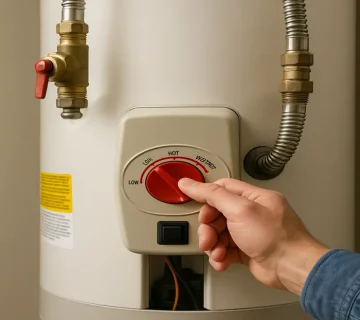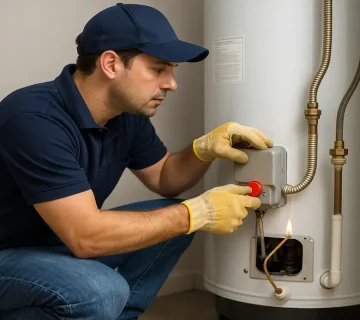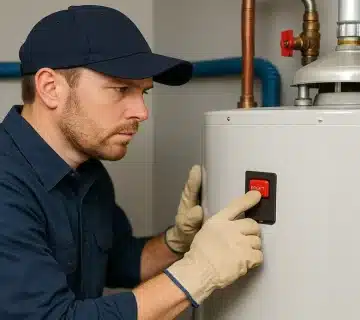Water heater problems can be frustrating, especially when they disrupt daily routines. A faulty unit can leave you without hot water, cause leaks, or even increase your energy bills. The good news is that many common water heater problems have simple solutions that homeowners can address before calling a professional.
This guide covers seven critical water heater problems, their causes, and the best ways to fix them efficiently.
1. No Hot Water
If your water heater isn’t producing hot water, it may be due to:
- A tripped circuit breaker (electric models)
- A pilot light that has gone out (gas models)
- A faulty thermostat or heating element
Fix:
- Check the circuit breaker and reset it if necessary.
- Relight the pilot light by following the manufacturer’s instructions.
- Adjust the thermostat to 120-140°F and replace any damaged components.
If the issue persists, the heating elements or gas control valve may need professional repair or replacement.
2. Water Temperature Fluctuations
If your water temperature is inconsistent, it may be caused by:
- Sediment buildup inside the tank, affecting heating efficiency
- A malfunctioning thermostat, causing incorrect temperature control
- A broken dip tube, mixing cold and hot water
Fix:
- Flush the tank to remove sediment buildup.
- Test and replace the thermostat if it’s not maintaining a steady temperature.
- Inspect the dip tube and replace it if it is broken.
3. Low Hot Water Pressure
Poor hot water pressure is often due to:
- Mineral buildup in pipes restricting water flow
- A partially closed shut-off valve, reducing pressure
- A clogged water heater inlet screen, limiting water entry
Fix:
- Flush the pipes and water heater to clear any debris.
- Fully open shut-off valves to restore proper flow.
- Clean or replace the inlet screen filter if clogged.
4. Leaking Water Heater
Leaks can originate from different sources, including:
- Loose plumbing connections, leading to water seepage
- A faulty temperature & pressure (T&P) relief valve, causing water discharge
- Internal tank corrosion, resulting in leaks from the bottom
Fix:
- Tighten loose plumbing connections to stop minor leaks.
- Replace a leaking T&P relief valve if water is escaping.
- If the tank itself is leaking, replacement is the best option.
5. Strange Noises from the Water Heater
If your water heater is making rumbling, popping, or hissing sounds, it could be caused by:
- Sediment buildup inside the tank, reducing efficiency
- Overheating heating elements, leading to noisy operation
- Excessive pressure, creating unusual sounds
Fix:
- Flush the water heater to remove accumulated sediment.
- Inspect and replace any faulty heating elements.
- Check the pressure relief valve to ensure it’s functioning correctly.
Ignoring these noises can lead to higher energy consumption and system failure.
6. Smelly or Discolored Water
Rusty or foul-smelling water may indicate:
- Bacteria growth in the tank, producing a sulfur-like smell
- A corroded anode rod, releasing rust particles
- Rusting pipes, affecting water quality
Fix:
- Flush the tank with hydrogen peroxide to kill bacteria.
- Replace the anode rod to prevent further rusting.
- Inspect the plumbing system to determine if rusty pipes need replacement.
7. Pilot Light Won’t Stay Lit (Gas Water Heaters)
For gas water heaters, a pilot light that repeatedly goes out could be caused by:
- A dirty thermocouple, blocking gas flow
- A faulty gas control valve, disrupting gas supply
- Drafts or airflow issues, blowing out the flame
Fix:
- Clean the thermocouple to remove dirt and soot buildup.
- Check for drafts around the heater and ensure proper ventilation.
- If necessary, replace the gas control valve.
When to Call a Professional
Some water heater problems require expert assistance. You should seek professional help if:
- The tank is leaking from the bottom, indicating internal corrosion
- The circuit breaker trips repeatedly, suggesting an electrical issue
- Rusty water continues after flushing, pointing to a failing tank
- A strong gas smell is present, requiring immediate attention
Ignoring serious water heater issues can lead to expensive repairs or system failure.
Preventive Maintenance Tips
To avoid common water heater problems, consider these maintenance steps:
✔ Flush the tank once a year to remove sediment buildup
✔ Test the pressure relief valve to ensure it’s working correctly
✔ Inspect plumbing connections for leaks or signs of wear
✔ Replace the anode rod every few years to prevent rust buildup
✔ Check the thermostat settings to maintain consistent heating
Routine maintenance helps extend the lifespan of your unit and reduce energy consumption.
Final Thoughts on Water Heater Problems and Fixes
Water heater problems range from minor inconveniences to major failures, but troubleshooting early warning signs can prevent costly repairs. By understanding common issues and their solutions, homeowners can maintain efficiency, improve performance, and extend the life of their water heater.
For expert water heater repair and installation, visit our website. You can also find us on Google Maps, Bing Maps, Yahoo Local, or check customer reviews on Yelp.





